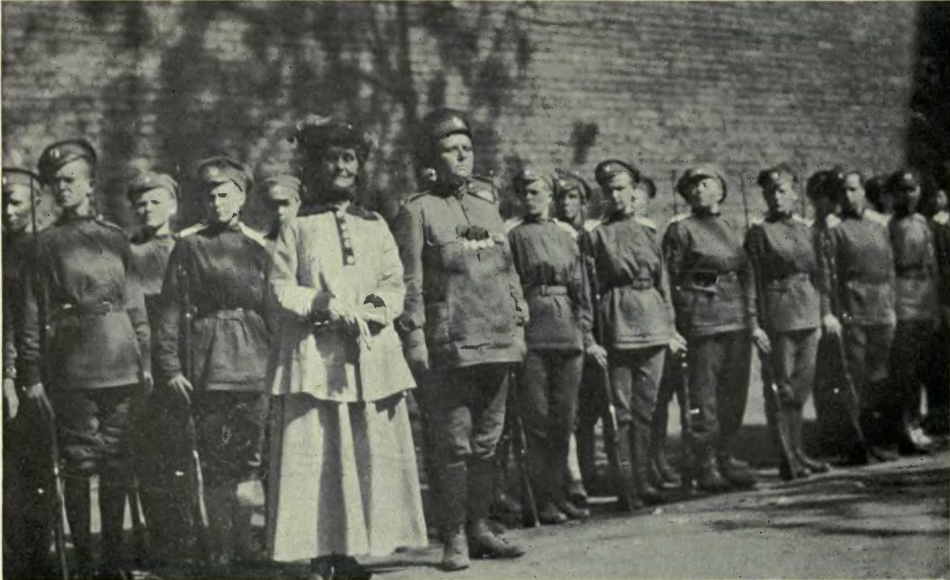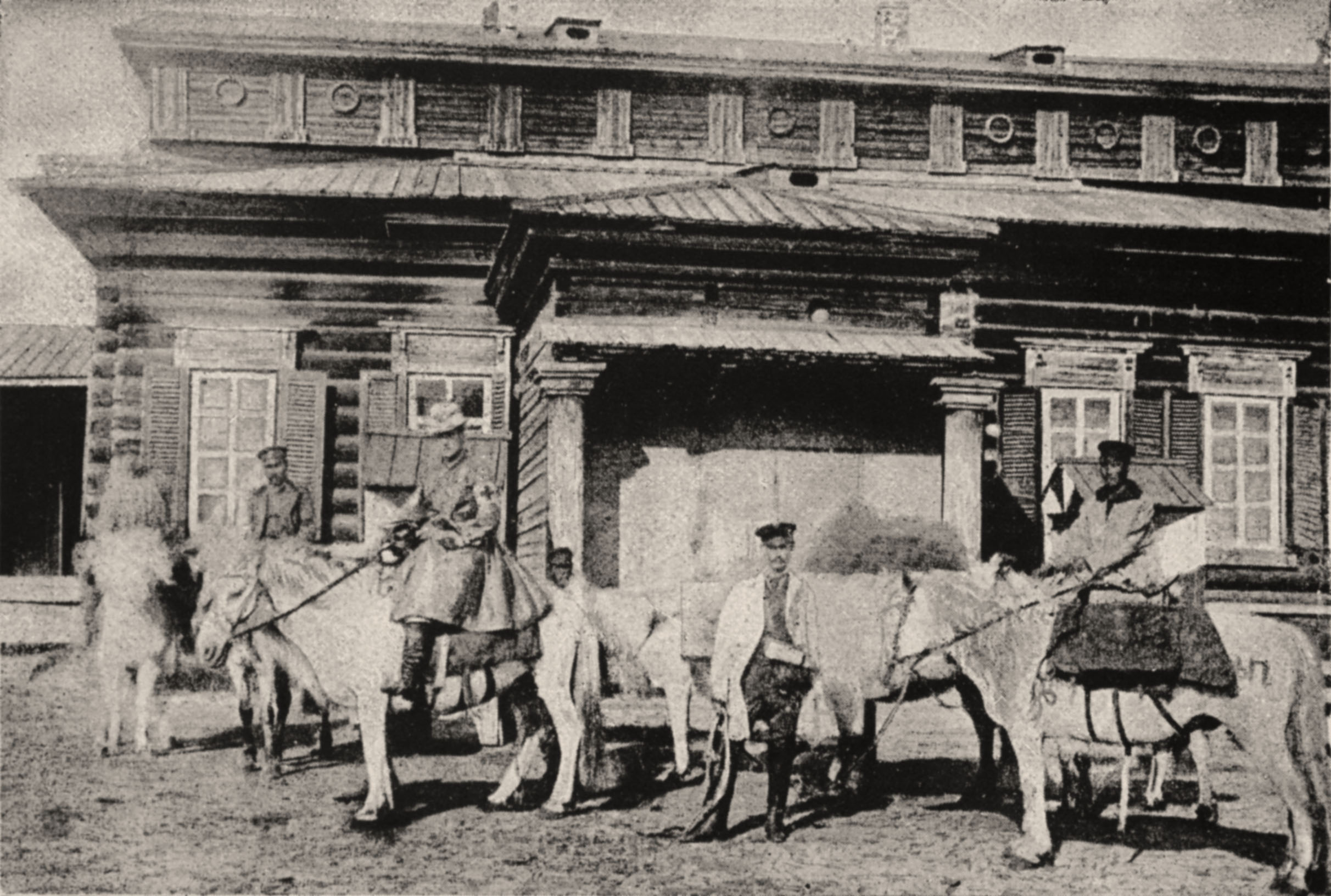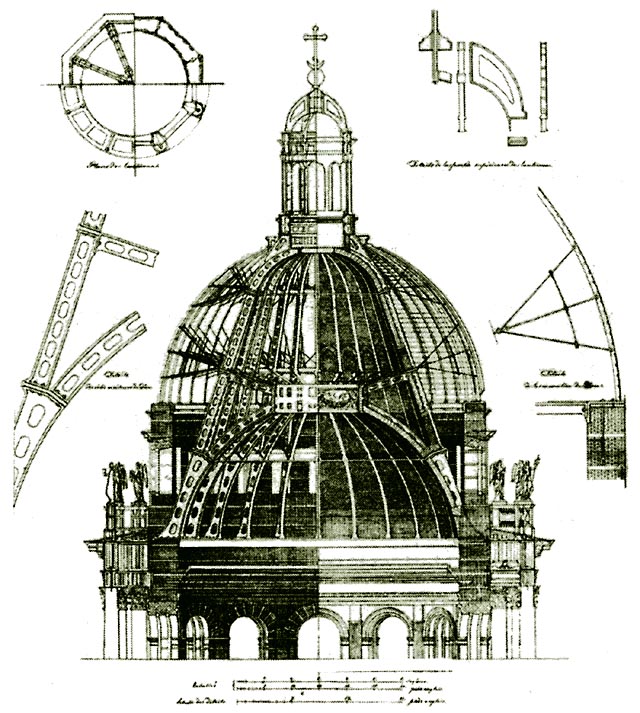|
Maria Bochkareva
Maria Leontievna Bochkareva (July 1889 – 16 May 1920; russian: Мари́я Лео́нтьевна Бочкарёва, Maria Leontievna Bochkareva, née ''Frolkova'' (Фролко́ва), nicknamed ''Yashka'') was a Russian soldier who fought in World War I and formed the 1st Russian Women's Battalion of Death. She was the first Russian woman to command a military unit. Early life Maria Frolkova was born to a peasant family in Nikolskoye in July 1889. Her father was a sergeant in the imperial army who fought in the Russo-Turkish War. She left home at sixteen to marry Afanasy Bochkarev. They moved to Tomsk, Siberia, where they worked as labourers. Her husband abused her, causing her to leave him. She found a job as a servant to employers who coerced her into working in their brothel. They moved her to Sretensk where Maria began a relationship with a local Jewish man named Yakov (or Yankel) Buk. She and Buk opened a butcher shop, but in May 1912 Buk was arrested for larceny and s ... [...More Info...] [...Related Items...] OR: [Wikipedia] [Google] [Baidu] |
Yakutsk
Yakutsk (russian: Якутск, p=jɪˈkutsk; sah, Дьокуускай, translit=Djokuuskay, ) is the capital city of the Sakha Republic, Russia, located about south of the Arctic Circle. Fueled by the mining industry, Yakutsk has become one of Russia's most rapidly growing regional cities, with a population of 355,443 at the 2021 Census. Yakutsk — where the average annual temperature is , winter high temperatures are consistently well below , and the record low is ,Погода в Якутске. Температура воздуха и осадки. Июль 2001 г. (in Russian) — is the coldest city in the world. Yakutsk is also the largest city located in [...More Info...] [...Related Items...] OR: [Wikipedia] [Google] [Baidu] |
Winter Palace
The Winter Palace ( rus, Зимний дворец, Zimnij dvorets, p=ˈzʲimnʲɪj dvɐˈrʲɛts) is a palace in Saint Petersburg that served as the official residence of the Emperor of all the Russias, Russian Emperor from 1732 to 1917. The palace and its precincts now house the Hermitage Museum. Situated between Palace Embankment and Palace Square, adjacent to the site of Peter the Great's original Winter Palace, the present and fourth Winter Palace was built and altered almost continuously between the late 1730s and 1837, when it was severely damaged by fire and immediately rebuilt. The storming of the palace in 1917, as depicted in Soviet art and in Sergei Eisenstein's 1928 film ''October'', became an iconic symbol of the Russian Revolution. The emperors constructed their palaces on a monumental scale that aimed to reflect the might and power of Russian Empire, Imperial Russia. From the palace, the tsars ruled over (almost 1/6 of the Earth's landmass) and Russian Empire Ce ... [...More Info...] [...Related Items...] OR: [Wikipedia] [Google] [Baidu] |
October Revolution
The October Revolution,. officially known as the Great October Socialist Revolution. in the Soviet Union, also known as the Bolshevik Revolution, was a revolution in Russia led by the Bolshevik Party of Vladimir Lenin that was a key moment in the larger Russian Revolution of 1917–1923. It was the second revolutionary change of government in Russia in 1917. It took place through an armed insurrection in Petrograd (now Saint Petersburg) on . It was the precipitating event of the Russian Civil War. The October Revolution followed and capitalized on the February Revolution earlier that year, which had overthrown the Tsarist autocracy, resulting in a liberal provisional government. The provisional government had taken power after being proclaimed by Grand Duke Michael, Tsar Nicholas II's younger brother, who declined to take power after the Tsar stepped down. During this time, urban workers began to organize into councils ( soviets) wherein revolutionaries criticized t ... [...More Info...] [...Related Items...] OR: [Wikipedia] [Google] [Baidu] |
Saint Petersburg
Saint Petersburg ( rus, links=no, Санкт-Петербург, a=Ru-Sankt Peterburg Leningrad Petrograd Piter.ogg, r=Sankt-Peterburg, p=ˈsankt pʲɪtʲɪrˈburk), formerly known as Petrograd (1914–1924) and later Leningrad (1924–1991), is the List of cities and towns in Russia by population, second-largest city in Russia. It is situated on the Neva River, at the head of the Gulf of Finland on the Baltic Sea, with a population of roughly 5.4 million residents. Saint Petersburg is the List of European cities by population within city limits, fourth-most populous city in Europe after Istanbul, Moscow and London, the List of cities and towns around the Baltic Sea, most populous city on the Baltic Sea, and the world's List of northernmost items#Cities and settlements, northernmost city of more than 1 million residents. As Russia's Imperial capital, and a Ports of the Baltic Sea, historically strategic port, it is governed as a Federal cities of Russia, federal city. ... [...More Info...] [...Related Items...] OR: [Wikipedia] [Google] [Baidu] |
Saint Isaac's Cathedral
Saint Isaac's Cathedral or Isaakievskiy Sobor (russian: Исаа́киевский Собо́р) is a large architectural landmark cathedral that currently functions as a museum with occasional church services in Saint Petersburg, Russia. It is dedicated to Saint Isaac of Dalmatia, a patron saint of Peter the Great, who had been born on the feast day of that saint. It was originally built as a cathedral but was turned into a museum by the Soviet government in 1931 and has remained a museum ever since, with church services held in a side chapel since the 1990's. In 2017, the Governor of Saint Petersburg offered to transfer the cathedral back to the Russian Orthodox Church, but this was not accomplished due to the protests of St Petersburg citizens opposing the offer. History The church on St Isaac's Square was ordered by Tsar Alexander I, to replace an earlier structure by Vincenzo Brenna, and was the fourth consecutive church standing at this place. A specially appointed com ... [...More Info...] [...Related Items...] OR: [Wikipedia] [Google] [Baidu] |
Petrograd Military District
The Petersburg Military District (Питербургский вое́нный о́круг) was a Military District of the Russian Empire originally created in August 1864 following Order B-228 of Dmitry Milyutin, the Minister of War of the Russian Empire. The order, signed on 10 (22) August established that "for local control of the Ground Armed Forces and military establishments, are formed ... Military-regional administrations in the following ten military districts" of which one was Petersburg. The District's forces gained combat experience in the Russo-Turkish (1877–1878) and Russo-Japanese (1904–05) wars. Finland Military District was merged into the Petersburg District in 1905. By a decision of Emperor Nicholas II on 24 August 1914, the names of units and establishments within the District were changed to Petrograd Military District. This District was established as a part of the RKKA by order в"– 71 of the Highest Military Council of 6 September 1918. On 1 Feb ... [...More Info...] [...Related Items...] OR: [Wikipedia] [Google] [Baidu] |
Alexander Kerensky
Alexander Fyodorovich Kerensky, ; original spelling: ( – 11 June 1970) was a Russian lawyer and revolutionary who led the Russian Provisional Government and the short-lived Russian Republic for three months from late July to early November 1917. After the February Revolution of 1917, he joined the newly formed provisional government, first as Minister of Justice, then as Minister of War, and after July as the government's second Minister-Chairman. He was the leader of the social-democratic Trudovik faction of the Socialist Revolutionary Party. Kerensky was also a vice-chairman of the Petrograd Soviet, a position that held a sizable amount of power. Kerensky became the prime minister of the Provisional Government, and his tenure was consumed with World War I. Despite mass opposition to the war, Kerensky chose to continue Russia's participation. His government cracked down on anti-war sentiment and dissent in 1917, which made his administration even more unpopular. ... [...More Info...] [...Related Items...] OR: [Wikipedia] [Google] [Baidu] |
Mikhail Rodzianko
Mikhail Vladimirovich Rodzianko (russian: Михаи́л Влади́мирович Родзя́нко; uk, Михайло Володимирович Родзянко; 21 February 1859, Yekaterinoslav Governorate – 24 January 1924, Beodra, Kingdom of Serbs, Croats and Slovenes) was a Russian statesman of Ukrainian origin. Known for his colorful language and conservative politics, he was the State Councillor and chamberlain of the Imperial family, Chairman of the State Duma and one of the leaders of the February Revolution of 1917, during which he headed the Provisional Committee of the State Duma. He was a key figure in the events that led to the abdication of Nicholas II of Russia on 15 March 1917. Life Rodzianko was born in the village of Popasne. He came from an old and rich noble family of Ukrainian origin and was educated at the '' Corps des Pages''. From 1877 until 1882 he served in the Her Majesty's Regiment of the Cavalry of the Guard. In 1884 Rodzianko married ... [...More Info...] [...Related Items...] OR: [Wikipedia] [Google] [Baidu] |
February Revolution
The February Revolution ( rus, Февра́льская револю́ция, r=Fevral'skaya revolyutsiya, p=fʲɪvˈralʲskəjə rʲɪvɐˈlʲutsɨjə), known in Soviet historiography as the February Bourgeois Democratic Revolution and sometimes as the March Revolution, was the first of two revolutions which took place in Russia in 1917. The main events of the revolution took place in and near Petrograd (present-day Saint Petersburg), the then-capital of Russia, where long-standing discontent with the monarchy erupted into mass protests against food rationing on 23 February Old Style (8 March New Style). Revolutionary activity lasted about eight days, involving mass demonstrations and violent armed clashes with police and gendarmes, the last loyal forces of the Russian monarchy. On 27 February O.S. (12 March N.S.) the forces of the capital's garrison sided with the revolutionaries. Three days later Tsar Nicholas II abdicated, ending Romanov dynastic rule and the Russia ... [...More Info...] [...Related Items...] OR: [Wikipedia] [Google] [Baidu] |
Polotsk
Polotsk (russian: По́лоцк; be, По́лацк, translit=Polatsk (BGN/PCGN), Polack (official transliteration); lt, Polockas; pl, Połock) is a historical city in Belarus, situated on the Dvina River. It is the center of the Polotsk District in Vitsebsk Voblast. Its population is more than 80,000 people. It is served by Polotsk Airport and Borovitsy air base. Nomenclature The Old East Slavic name, ''Polotesk'', derives from the Polota river, which flows into the neighboring Western Dvina. The Vikings rendered that name as ''Palteskja''. History Polotsk is one of the most ancient cities of the Eastern Slavs. The '' Primary Chronicle'' (a history of Kievan Rus' from about 850 to 1110, compiled in Kiev about 1113) listed Polotsk in 862 (as Полотескъ, /poloteskŭ/), together with Murom and Belozersk. However, an archaeological expedition from the Institute of History of the National Academy of Sciences of Belarus suggests that Polotsk existed in th ... [...More Info...] [...Related Items...] OR: [Wikipedia] [Google] [Baidu] |








